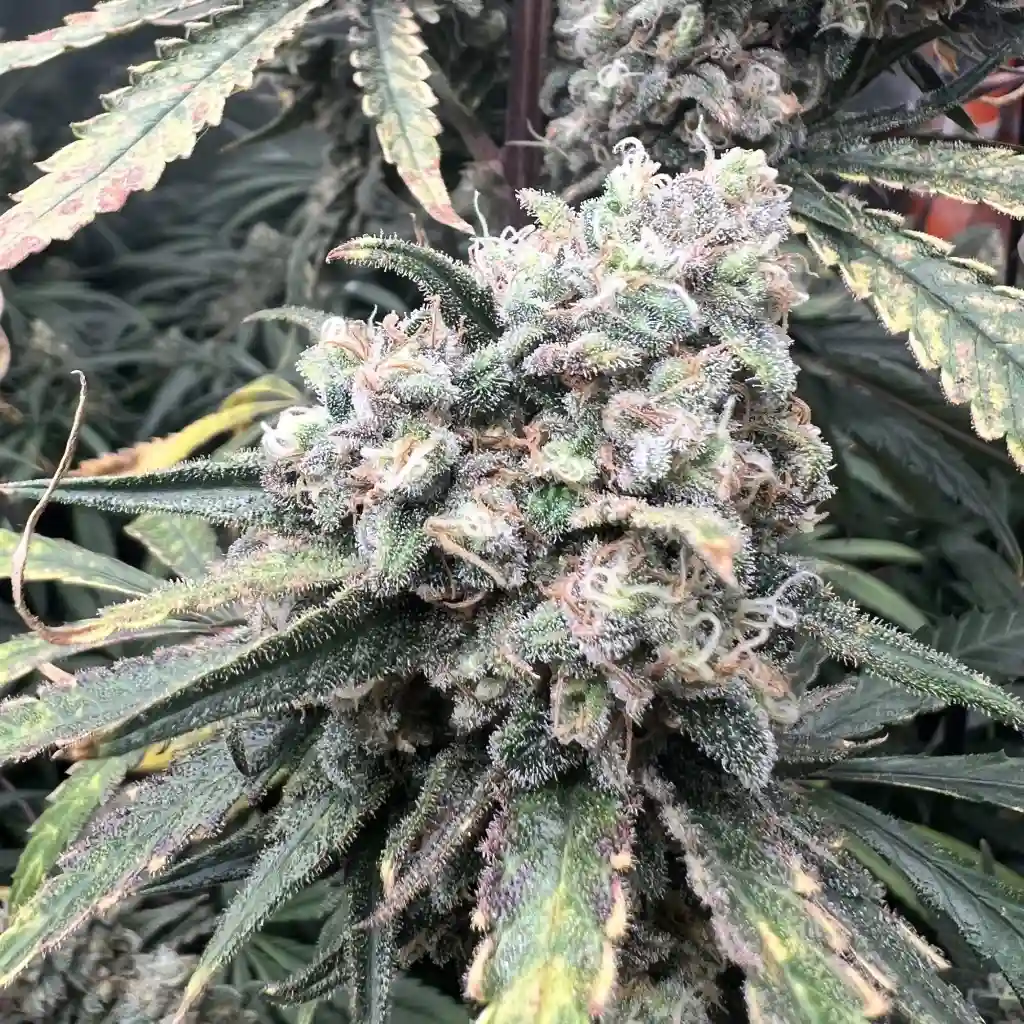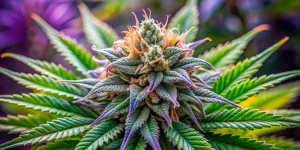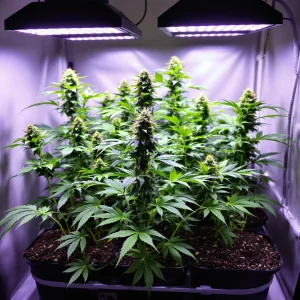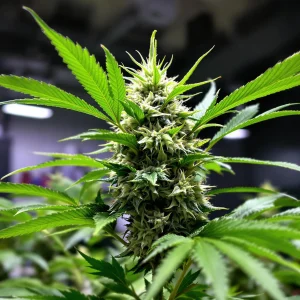Exceptional Genetics and Effects
Flower Bomb Kush strain is an indica-dominant hybrid known for its potent effects and unique flavor profile. Created by crossing Green Crack with OG Kush, this strain offers a rich blend of citrus, earthy, and spicy notes. With THC levels ranging from 18% to 22%, Flower Bomb Kush delivers a relaxing body high paired with subtle cerebral stimulation. These effects make it a favorite among medicinal and recreational users alike, ideal for alleviating stress, anxiety, and chronic pain. Its balanced effects and dense, resin-coated buds have earned it a reputation as a top-tier strain for growers and consumers.
Flower Bomb Kush has a relatively fast flowering time, making it a favorite among growers seeking quick harvests without compromising quality. The strain’s terpene profile is dominated by myrcene, limonene, and caryophyllene, contributing to its signature aroma and therapeutic properties. This combination of effects, flavor, and ease of cultivation makes it a standout choice for both novices and experienced cultivators.
Environmental Requirements for Growing Flower Bomb Kush Strain
Flower Bomb Kush thrives in a stable environment with moderate temperatures and controlled humidity. During the vegetative phase, keep temperatures between 70-85°F (21-29°C) and humidity levels around 50-70%. In the flowering phase, reduce humidity to 40-50% to prevent mold and encourage dense bud development. Good airflow is essential to prevent fungal issues and support healthy growth. Whether growing indoors or outdoors, ensure consistent monitoring of environmental factors to achieve optimal results.
The strain’s robust genetics make it adaptable to various climates, but it performs best in Mediterranean-like conditions. If growing in regions with extreme temperatures, using greenhouses or indoor setups can help maintain stable conditions. Regularly check for any signs of environmental stress to ensure the plants reach their full potential.
Setting Up the Growing Cannabis Space
Indoor Cannabis Cultivation
Flower Bomb Kush performs exceptionally well in indoor setups where conditions can be controlled. Use full-spectrum LED lights to provide the necessary illumination and maintain an 18/6 light schedule during the vegetative phase. Transition to a 12/12 light cycle for flowering. Soil or hydroponic systems are both effective, but ensure the pH is within the ideal range: 6.0-6.5 for soil and 5.5-6.0 for hydroponics. Implement pruning and low-stress training (LST) techniques to maximize light penetration and airflow.
Indoor cultivation also allows growers to manage light intensity and spectrum, which directly influences the potency and yield of Flower Bomb Kush. Installing carbon filters can help manage the strain’s pungent aroma, ensuring discretion in shared living spaces or urban environments.
Outdoor Cannabis Cultivation
Outdoors, Flower Bomb Kush flourishes in a Mediterranean-like climate with plenty of sunlight. Choose a well-draining, nutrient-rich soil to support growth. Plant after the last frost to ensure stable temperatures and avoid harsh weather conditions. The strain’s hardy genetics make it suitable for slightly cooler regions, but consistent monitoring is crucial. Use stakes or trellises to support the plant’s structure, especially as buds develop. For those looking for a compact, fast-finishing option, Corleone Kush Autoflower is also a great alternative for outdoor setups.
When growing outdoors, ensure the plants are spaced adequately to allow for airflow, reducing the risk of mold or mildew. Regularly inspect for pests and environmental changes that could impact growth. With proper care, outdoor plants can produce significantly higher yields compared to indoor setups.
Propagation and Germination of Flower Bomb Kush Strain
Start with high-quality Flower Bomb Kush seeds to ensure robust genetics. The paper towel method is a popular and effective way to germinate seeds: place them between moist paper towels in a warm, dark environment. Within 24-72 hours, taproots should appear. Transfer the germinated seeds into small pots filled with light, aerated soil, and maintain a temperature of 75-80°F (24-27°C). Provide gentle light and avoid overwatering to prevent damping off.
For growers preferring direct soil germination, plant the seeds approximately half an inch deep in nutrient-rich soil. Keep the medium moist and maintain consistent temperatures. This method reduces transplant shock and supports robust early root development.
Vegetative Phase of Flower Bomb Kush Strain
The vegetative phase is where Flower Bomb Kush’s indica traits shine, with bushy growth and broad leaves. Maintain an 18/6 light schedule and provide nitrogen-rich nutrients to encourage robust foliage development. Pruning and topping are essential to manage the plant’s shape and improve light distribution. Regularly inspect for pests or nutrient deficiencies, and adjust your care routine as needed to ensure healthy growth.
During this phase, the plant focuses on building a strong root system and thick stems to support future bud growth. Training techniques such as topping or mainlining can optimize canopy structure and increase overall yield potential.
Flowering Phase of Flower Bomb Kush Strain
Flower Bomb Kush transitions to flowering after 8-10 weeks of vegetative growth. During this phase, switch to bloom-specific nutrients rich in phosphorus and potassium. The flowering stage typically lasts 8-9 weeks, during which buds develop a dense, resinous structure. Monitor trichome development to determine the ideal harvest time; milky trichomes with a few amber hues indicate peak potency. Maintain proper airflow and humidity levels to prevent mold and mildew. As flowering progresses, the plant’s aroma intensifies, filling the grow space with a sweet, earthy scent. Pay close attention to the buds’ development to avoid over-ripening, which can diminish potency and flavor.
Cannabis Fertilization and Nutrition – Flower Bomb Kush Strain
Nutritional needs change throughout Flower Bomb Kush’s growth cycle. During the vegetative stage, use fertilizers high in nitrogen to support leafy growth. As the plant transitions to flowering, switch to nutrients rich in phosphorus and potassium to enhance bud formation and resin production. Incorporate organic amendments like bat guano, kelp, and compost to boost soil quality and improve flavor profiles. Avoid overfeeding to prevent nutrient burn, and flush the plants with plain water during the final two weeks before harvest for clean, flavorful buds.
Using organic fertilizers not only improves the strain’s terpene profile but also contributes to a cleaner final product. Regularly monitor soil pH and nutrient levels to ensure optimal absorption and prevent imbalances.
Pest and Disease Control for Cannabis Growing
Prevention
Preventing pests and diseases is crucial for a successful grow. Maintain cleanliness in the grow area and use sticky traps to monitor insect activity. Neem oil and insecticidal soaps are effective natural deterrents. Companion planting with pest-repelling herbs like basil and marigold can provide additional protection.
Additionally, consistent pruning and airflow management can reduce the risk of mold and mildew. Using sterilized tools for pruning minimizes the chances of introducing pathogens to the plants.
Corrective Actions
If pests or diseases occur, act swiftly to minimize damage. Introduce beneficial insects like ladybugs or predatory mites to combat infestations naturally. For fungal issues, improve airflow and apply organic fungicides. Regular inspections and prompt interventions ensure healthy plants and high-quality yields.
For severe infestations, isolate affected plants to prevent the spread and apply targeted treatments. Always test new treatments on a small area before full application to avoid adverse effects.
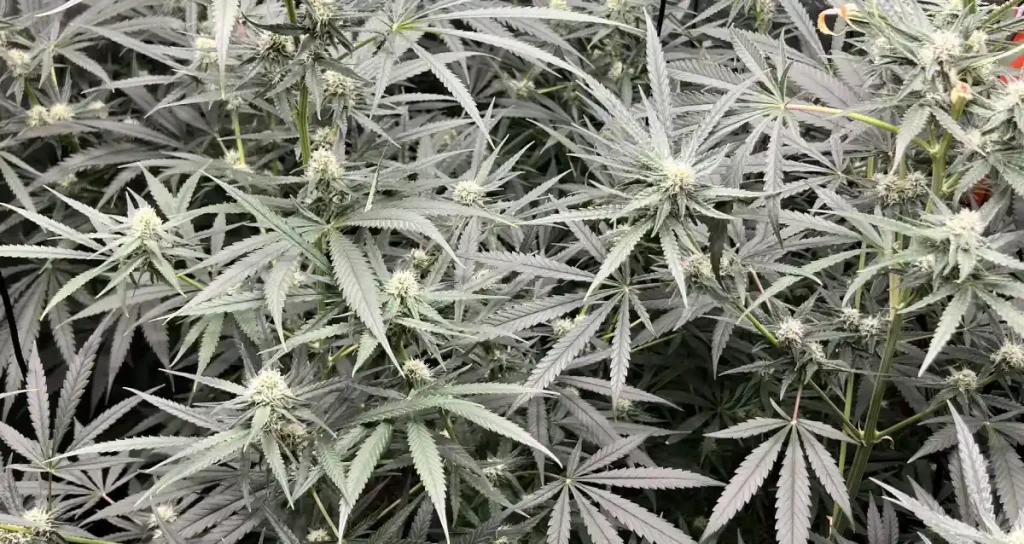
Harvesting and Curing for Cannabis Growing
Harvest Flower Bomb Kush when trichomes are mostly milky with some amber hues, indicating peak potency. Use sterilized scissors to trim buds and hang them upside down in a dark, ventilated space with 45-55% humidity and temperatures around 65-70°F (18-21°C). Once dried, cure the buds in airtight glass jars, opening them daily for the first week to release excess moisture. Proper curing enhances the strain’s flavor, aroma, and potency. Extending the curing process beyond two weeks can further refine the strain’s flavor and smoothness. Regularly check the jars for mold or excess moisture to ensure a successful cure.
Is Flower Bomb Kush Strain Indica or Sativa?
Flower Bomb Kush is an indica-dominant hybrid, offering a blend of relaxing body effects and mild cerebral stimulation. Its balanced profile makes it suitable for evening use or unwinding after a long day, while still allowing for some mental clarity and focus.
Advantages of Growing Flower Bomb Kush Strain
This strain’s robust genetics make it resistant to common pests and diseases, making it an excellent choice for both novice and experienced growers. Its high yield potential and dense, resinous buds make it a favorite for cultivators looking to maximize their harvest. Additionally, its unique flavor profile and potent effects ensure a rewarding experience for both growers and consumers.
Flower Bomb Kush’s versatility allows it to thrive in both indoor and outdoor settings. Its relatively short flowering time and high resin production also make it a popular choice for extract enthusiasts.
Disadvantages of Growing Flower Bomb Kush Strain
Despite its resilience, Flower Bomb Kush requires consistent care to achieve its full potential. Its bushy structure demands regular pruning and training to maintain airflow and light penetration. Beginners may find its nutrient requirements challenging, as improper feeding can lead to deficiencies or nutrient burn. Monitoring environmental conditions closely is essential for success. Another consideration is the strain’s strong aroma, which may require odor management solutions, particularly in shared or urban growing environments.
Problems in Cultivating Flower Bomb Kush Strain
Common issues when growing Flower Bomb Kush include overwatering, nutrient imbalances, and pest infestations. Regular monitoring and proper care can mitigate these challenges. Training techniques like topping and low-stress training (LST) help manage the plant’s structure and optimize light exposure, ensuring healthy growth and high yields. Growers should also be cautious of temperature fluctuations, which can stress the plant and reduce overall yield and quality.
Advanced Pest Control for Cannabis Growing
For severe infestations, consider integrated pest management (IPM) strategies. Introduce biological controls like Bacillus thuringiensis to target caterpillars and other pests. Predatory insects such as ladybugs can effectively manage smaller pests. Maintaining a clean and organized grow space is key to preventing recurring issues.
Advanced methods such as introducing microbial fungicides or using beneficial nematodes can further enhance pest and disease resistance, ensuring healthy plants throughout the growth cycle.
Similar Strains to Flower Bomb Kush Strain
Gorilla Glue #4
Gorilla Glue #4, also known as GG4, is a potent hybrid strain celebrated for its relaxing and euphoric effects. This strain features a sticky resin profile and earthy, sour aromas. Its high THC levels make it ideal for users seeking relief from stress and chronic pain. Like Flower Bomb Kush, Gorilla Glue #4 thrives in controlled indoor environments but is also resilient enough for outdoor cultivation in warm climates.
When growing GG4, you’ll notice its dense buds and high resin production, making it a favorite among concentrate producers. It requires consistent trimming and training to manage its vigorous growth and optimize yields.
Blue Dream
Blue Dream is a sativa-dominant hybrid known for its balanced effects, blending full-body relaxation with gentle cerebral stimulation. Its sweet berry aroma, a characteristic inherited from its Blueberry parent, makes it a delightful strain to grow and consume. This strain’s resistance to pests and mold makes it suitable for warm and humid climates.
Blue Dream’s growth cycle aligns well with Flower Bomb Kush’s, offering robust yields in a relatively short period. Its versatility and forgiving nature make it an excellent option for both novice and experienced growers.
OG Kush
OG Kush is a classic strain that has paved the way for many modern hybrids. Renowned for its piney, earthy aroma and potent effects, OG Kush delivers a calming high that’s ideal for unwinding. It shares Flower Bomb Kush’s preference for warm, sunny climates but requires careful monitoring to avoid mold and pests.
This strain’s compact growth pattern makes it suitable for indoor grows with limited space. With proper feeding and care, OG Kush rewards growers with dense, resinous buds and a high THC content.
Week-by-Week Growth Plan for Flower Bomb Kush Strain
Week 1-2: Germination and Seedling Stage
Start by germinating high-quality Flower Bomb Kush seeds using the paper towel method or directly in a light, well-draining seedling mix. Maintain temperatures between 70°F and 80°F and a humidity level of 65-70%. Provide 18-24 hours of light daily using CFL or LED grow lights.
During this stage, focus on keeping the soil moist but not soggy. Once the seedlings sprout, monitor for healthy green growth and ensure they’re not stretching excessively by keeping the light source close but not too intense.
Week 3-4: Early Vegetative Stage
Transplant the seedlings into larger pots with nutrient-rich soil. Increase light intensity and maintain an 18/6 light schedule. Introduce a nitrogen-rich fertilizer to support foliage development.
Keep temperatures steady at 75°F to 85°F and humidity around 60%. Begin training techniques like topping or low-stress training (LST) to shape the plant and improve light penetration.
Week 5-6: Late Vegetative Stage
As the plant enters the late vegetative stage, it will show vigorous growth. Maintain consistent feeding with a balanced nutrient mix rich in nitrogen, phosphorus, and potassium. Keep humidity levels at 50-55% to prevent mold.
Prune lower leaves and branches to focus the plant’s energy on canopy development. Ensure good air circulation and maintain a stable light cycle.
Week 7-8: Early Flowering Stage
Switch to a 12/12 light cycle to initiate flowering. Replace the vegetative nutrients with a bloom-specific formula rich in phosphorus and potassium. Keep humidity levels at 40-50% to reduce the risk of bud rot.
Monitor the plant closely for pre-flower signs, and begin staking or tying branches to support the developing buds.
Week 9-10: Mid Flowering Stage
The plant will now produce dense buds covered in trichomes. Continue feeding with bloom nutrients and consider adding supplements like molasses or bloom boosters. Reduce humidity further to 35-40% and maintain temperatures around 75°F.
Inspect buds for mold and pests daily. Avoid overwatering, as it can lead to root issues and affect bud quality.
Week 11-12: Late Flowering and Harvest
In the final weeks, flush the soil with plain water to remove nutrient buildup. Trichomes will shift from clear to milky white with hints of amber, signaling peak potency. Reduce light intensity slightly to mimic natural conditions.
Harvest the buds when the desired trichome color is achieved. Cut the branches and prepare them for drying.
FAQs About Flower Bomb Kush Strain
What’s the THC content of Flower Bomb Kush?
Flower Bomb Kush typically features THC levels ranging between 19% and 25%. Its high potency delivers a relaxing yet uplifting effect, making it ideal for both recreational and medicinal users. Beginners should start with smaller doses to gauge their tolerance.
How long does it take to grow Flower Bomb Kush?
The entire growth cycle of Flower Bomb Kush lasts about 10-12 weeks. This includes 4-6 weeks in the vegetative stage and 6-8 weeks in the flowering stage. Proper care and optimal environmental conditions can significantly enhance yields within this timeline.
Is Flower Bomb Kush suitable for outdoor growing?
Yes, Flower Bomb Kush thrives outdoors in warm, sunny climates. Its robust genetics make it resilient against environmental stressors, but growers should monitor for mold and pests in humid regions. With sufficient space and care, outdoor plants can yield impressively large harvests.

